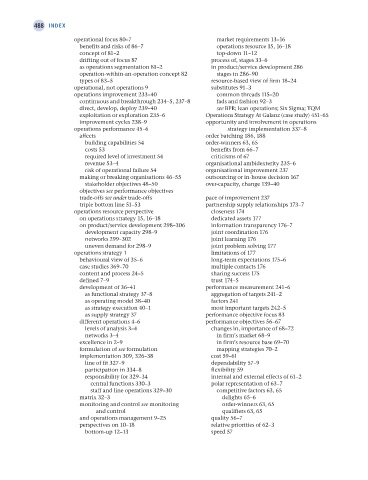Page 513 - Operations Strategy
P. 513
488 Index
operational focus 80–7 market requirements 13–16
benefits and risks of 86–7 operations resource 15, 16–18
concept of 81–2 top-down 11–12
drifting out of focus 87 process of, stages 33–6
as operations segmentation 81–2 in product/service development 286
operation-within-an-operation concept 82 stages in 286–90
types of 83–5 resource-based view of firm 18–24
operational, not operations 9 substitutes 91–3
operations improvement 233–40 common threads 115–20
continuous and breakthrough 234–5, 237–8 fads and fashion 92–3
direct, develop, deploy 239–40 see BPR; lean operations; Six Sigma; TQM
exploitation or exploration 235–6 Operations Strategy At Galanz (case study) 451–65
improvement cycles 238–9 opportunity and involvement in operations
operations performance 45–6 strategy implementation 337–8
affects order batching 186, 188
building capabilities 54 order-winners 63, 65
costs 53 benefits from 66–7
required level of investment 54 criticisms of 67
revenue 53–4 organisational ambidexterity 235–6
risk of operational failure 54 organisational improvement 237
making or breaking organisations 46–55 outsourcing or in-house decision 167
stakeholder objectives 48–50 over-capacity, change 139–40
objectives see performance objectives
trade-offs see under trade-offs pace of improvement 237
triple bottom line 51–53 partnership supply relationships 173–7
operations resource perspective closeness 174
on operations strategy 15, 16–18 dedicated assets 177
on product/service development 298–306 information transparency 176–7
development capacity 298–9 joint coordination 176
networks 299–302 joint learning 176
uneven demand for 298–9 joint problem solving 177
operations strategy 1 limitations of 177
behavioural view of 35–6 long-term expectations 175–6
case studies 369–70 multiple contacts 176
content and process 24–5 sharing success 175
defined 7–9 trust 174–5
development of 36–41 performance measurement 241–6
as functional strategy 37–8 aggregation of targets 241–2
as operating model 38–40 factors 241
as strategy execution 40–1 most important targets 242–5
as supply strategy 37 performance objective focus 83
different operations 4–6 performance objectives 56–67
levels of analysis 3–4 changes in, importance of 68–72
networks 3–4 in firm’s market 68–9
excellence in 2–9 in firm’s resource base 69–70
formulation of see formulation mapping strategies 70–2
implementation 309, 326–38 cost 59–61
line of fit 327–9 dependability 57–9
participation in 334–8 flexibility 59
responsibility for 329–34 internal and external effects of 61–2
central functions 330–3 polar representation of 63–7
staff and line operations 329–30 competitive factors 63, 65
matrix 32–3 delights 65–6
monitoring and control see monitoring order-winners 63, 65
and control qualifiers 63, 65
and operations management 9–25 quality 56–7
perspectives on 10–18 relative priorities of 62–3
bottom-up 12–13 speed 57
Z20 Operations Strategy 62492.indd 488 09/03/2017 14:48

